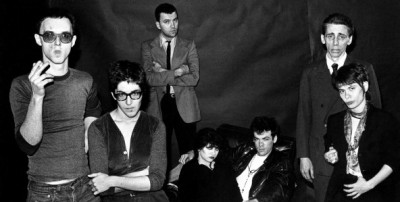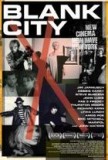| Reviews & Columns |
|
Reviews DVD TV on DVD Blu-ray 4K UHD International DVDs In Theaters Reviews by Studio Video Games Features Collector Series DVDs Easter Egg Database Interviews DVD Talk Radio Feature Articles Columns Anime Talk DVD Savant Horror DVDs The M.O.D. Squad Art House HD Talk Silent DVD
|
DVD Talk Forum |
|
|
| Resources |
|
DVD Price Search Customer Service #'s RCE Info Links |
|
Columns
|
|
|
Blank City

Nothing makes this cinephile happier than a good movie about movies--I've watched Z Channel and The Celluloid Closet and A Decade Under the Influence and This Film Is Not Yet Rated more times than I'd care to count, and while Blank City may not quite approach the five-star quality of those films, it is still a stellar, well-constructed doc that vividly recaptures a very specific moment in underground cinema.
Its opening passages are its best; director Celine Danhier is skilled with montage, and she assembles a fast-paced, eye-catching collection of striking images that sucks you right in to New York's East Village in the late 1970s. She's also good with context, utilizing period footage and eloquent, often witty recollections of just about anybody who was everybody in that scene to help explain where America, New York, and cinema were when a bunch of artists, writers, musicians, and misfits started picking up Super-8 cameras and making movies their own way, following their own rules.
They tell some great stories. Amos Poe relates how he talked the Maysles brothers into renting him an editing room for 40 bucks so he could cut his feature The Blank Generation; they were willing to do it but they'd only give him 24 hours, so he and his co-director took some speed and got on with it. John Lurie relates how he lived in the apartment below filmmaker Eric Mitchell, who would run an extension cord into Laurie's window when his electricity got shut off (Lurie muses that if Mitchell pissed him off, he'd go unplug the cord). Jim Jarmusch shot much of his first feature in Lurie's apartment; he notes that Jean Michel Basquiat was crashing on Lurie's floor at the time, so he is often right out of the frame in the film. And James Nares tells a priceless story about how they completely stole an interior location for his Rome '78.
The enthusiasm that they had, and still have, is infectious; everybody was being creative, everybody was working with everyone else, no one had any money, and they were having a great time. Cross-pollination was the order of the day--musicians were acting, filmmakers were in bands, painters were directing film. "Nobody was doing what they knew how to do," Lurie laughs.
Admittedly, that sometimes shows. Danhier just grabs a line or two from this film, some shots from that one, but some of these films seem, candidly, just unbearable. At this point in time, the stories behind them may be more interesting than the films themselves; they were important, they made waves, and they gave a lot of important directors, actors, and musicians their start. And you can't deny that even the worst of them had a genuine energy, a heedless abandon that this film shares--it's got a great momentum.
J. Hoberman called the movement "No Wave Cinema," and as it started to gain momentum, some of the filmmakers got real financing and budgets and their films started to play outside of the East Village. Titles like Wild Style and Stranger In Paradise got the No Wave filmmakers wondering about "maybe working on the edge of Hollywood;" Danhier expertly explains, through interviews and clips, how their entire movement started changing just as it was getting noticed.
So a (mostly) new group of filmmakers tore it all down and started over. "The cinema of transgression" movement that grew out of "No Wave"'s ashes was darker, rougher, edgier; these filmmakers were interested in shocking their audience with extrememe images and subject matter heretofore unseen. Much of this was, again, in response to the times; they were in the 1980s, struggling to scream from within Reagan's America.
To these eyes, it is in this section that Blank City falters; it runs just a little too long, and you can feel that in the last half-hour or so. The fact of the matter is, the second movement isn't nearly as interesting as the first. They all just seem like annoying, truculent nihilists; performer Lydia Lunch says of director Nick Zedd, "Even when he did nothing, people hated him," and I know what she means. I worried that my preference for the earlier sections was just because they were interviewing participants that I knew and liked (Jarmusch, Lurie, Steve Buscemi, etc). Then I realized that there is a reason that I've heard of them and not the folks in the second half.
So it could use some tightening there. But Blank City is still a terrific documentary, with great clips, funny and insightful interviews (seriously, is there a movie that John Waters didn't improve by sitting down to talk?), and a palpable love of the subject matter. The movies "may have been naïve, or badly made," someone notes at the end. "...but they were passionate." Indeed.
Jason lives in New York. He holds an MA in Cultural Reporting and Criticism from NYU.
|
| Popular Reviews |
| Sponsored Links |
|
|
| Sponsored Links |
|
|
| Release List | Reviews | Shop | Newsletter | Forum | DVD Giveaways | Blu-Ray | Advertise |
|
Copyright 2024 DVDTalk.com All Rights Reserved. Legal Info, Privacy Policy, Terms of Use,
Manage Preferences,
Your Privacy Choices | |||||||











